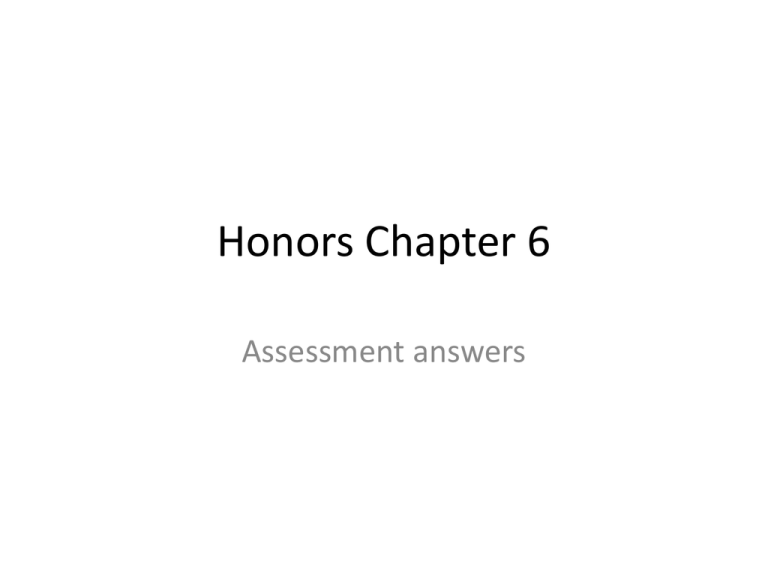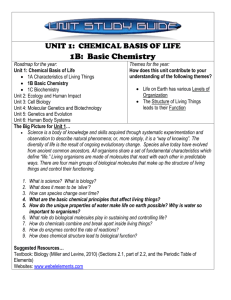Honors Chapter 6
advertisement

Honors Chapter 6 Assessment answers Section 1 1. What is the smallest unit of matter? Atom 2. How are atoms and elements related? The same type of atoms make up an element 3. List the similarities and differences among protons, electrons, and neutrons. All of these are similar because they make up an atom. Protons, neutrons in nucleus Electrons in outer shell Protons positive Electrons negative Neutrons neutral 4. How does the location of the electrons in an atom allow them to be involved in bonding? Electrons in the outer shell will be nearer to the outer shells of other atoms and allow them to bond covalently. 5. Look in the textbook on p. 149 Figure 6.3. What is the most abundant element that exists in living things? Hydrogen 6. How does the atom of an isotope differ from the atom of the same element? How are they the same? Differ in the number of neutrons Similar because they have the same number of electrons & protons 7. What type of medical test makes use of radioisotopes? P. 150 in textbook Radiation therapy, x-rays 8. Why is CO, carbon monoxide not an element? It is a compound of carbon and oxygen; 2 different elements 9. Are all compounds molecules? No Why or why not? Only compounds formed by covalent bonding are molecules 10. Compare van der Waals forces, ionic bonds, and covalent bonds. Van der Waals hold molecules together Ionic and covalent bonds hold atoms together Covalent bonds – electrons are shared between atoms Ionic bonds – electrical attractions between two oppositely charged atoms 11. How does the atom of an isotope differ from the atom of the same element? Number of neutrons 12. What factor determines that an oxygen atom can form two covalent bonds while a carbon atom can form four? The number of electrons in the outer shell Carbon has 4 Oxygen has 6 Honors 6.2 assessment 1. What is the relationship between a chemical bond and a chemical reaction? Chemical bonds are create or broken by chemical reactions 2. Why must chemical equations be balanced? Because the law of conservation of mass states that matter cannot be created or destroyed; matter can only change forms 3. Practice balancing equations. 6K + B2O3 -> 3K2O + 2B HCl + NaOH -> NaCl + H20 4. What are enzymes? Special proteins that act as a catalyst to speed up the rate of a biological reaction. 5. What effect does an enzyme have on a chemical reaction? It lowers the activation energy of the reaction so the rate of the reaction speeds up 6. Identify the parts of this chemical reaction: A+B AB Reactants Products 7. Why do the number of atoms of reactants have to equal the number of atoms of products formed? Because of conservation of mass 8. Compare and contrast the substrate and active site. Both are part of enzyme substrate complex active site – specific place where a substrate binds on an enzyme substrate – reactant of an enzyme-catalyzed reaction 9. Identify and describe factors that can influence enzyme activity. Temperature, pH, and other substances 6.3 assessment 1. Distinguish between solutions and suspensions. Give an example of each. Solutions are mixtures that has substances evenly mixed throughout (homogeneous). Example: salt water. Suspensions are heterogenous mixtures that separate over time. Example: sand and water. 2. Relate the structure of water to its ability to act as a solvent. Water is a polar molecule meaning it has unequal charges. Positive charges are attracted to negative charges on other water molecules and other solutes. 3. Baking soda is a basic substance. Describe the effect of baking soda on the H+ ion concentration of stomach contents with pH 4. The baking soda will buffer the H+ ions because it has more OH- ions. Therefore, the substance will be less acidic and the pH will rise. 4. If you add hydrochloric acid to water, what effect would this have on the H+ ion concentration? On the pH? Increase the H+ ions but decrease the pH number 5. What is the relationship between a. solution----mixture A solution is a type of mixture b. pH-----buffer Buffer is a substance that is added to a solution to adjust H+ so that pH is changed be more acidic or basic c. acid---base Acids and bases can both be measured by concentration of H+ through pH scale. The more H+ there are, the more acidic the solution. The less H+, the more basic the solution. d. solvent---solute A solute is dissolved by a solvent. e. polar molecule---hydrogen bond A polar molecule is able to form hydrogen bonds because of the unequal charges around the molecule. 6. Hydrochloric acid (HCl) is a strong acid. What ions are formed when HCl dissolves in water? H+ and ClWhat effect of HCl on the pH of water? It would decrease the pH, because of the increase in H+ ion concentration 7. Compare and contrast adhesion and cohesion. Water is cohesive and adhesive Cohesive means the water molecules stick to each other Adhesive means the water molecules stick to other substances 8. Why is water considered the universal solvent? Because it will mix with more substances than any other solvent 9. Give an example of a homogenous and heterogenous mixture. Homogenous – food coloring and water Heterogenous – fruit salad 6.4 1. What is the name of the element that is found in all living things? carbon 2. How many bonds can this element’s atom form with other atoms? four 3. What kind of bond does it form? covalent 4. What is the name of the type of chemistry that studies only this element? organic 5. What is a macromolecule? A giant molecule made of hundreds or thousands of smaller molecules 6. What are some other names that are used in place of macromolecules? Polymers, organic molecules 7. What is a monomer? small molecules that can join with other small molecules to make larger molecules ( macromolecules) 8. What is polymerization? process of making macromolecules/polymers by joining smaller compounds together 9. What are the four major categories of macromolecules? carbohydrates, lipids, proteins, and nucleic acids. 10.What monomer makes up the macromolecule carbohydrate? monosaccharide 11.What elements make up a carbohydrate? Carbon, hydrogen, oxygen 12. What is it called when you have 2 monosaccharides together? dissacharide What about 100? Polysaccharide 13. One of the functions of a carbohydrate is to store energy. What are the two types of polysaccharides discussed that store energy? Starches and glycogen 14. Which types of polysaccharides provide structural support to organisms? Cellulose and chitin 15. What is the formula for a carbohydrate? —(CH2O)n 16. Give some examples of lipids. Fats, oil, & waxes 17. What is the monomer for a lipid. Fatty acid and glycerol 18.Lipids are nonpolar. What does that mean? That this molecule has equal charges around it therefore; lipids do not mix well with other substances 19. What is a phospholipid and where can it be found? A lipid joined to a lipid molecule; found in the cell membrane; doesn’t mix well with water so it makes a good barrier for the cell 20.What are the elements found in lipids? Carbon and hydrogen 21. What is a saturated fat? lipids that have tail chains made up of only single bonds between the carbon atoms. 22.What is an unsaturated fat? Lipids that have tail chains with at least one double bond between the carbon atoms. 23. What is a polyunsaturated fat? A lipid with more than one double bond between the carbon bonds 24.What are the monomers for the macromolecule protein? Amino acids 25. What are the elements found in proteins? Carbon, hydrogen, oxygen, sulfur and nitrogen 26. What are the components of an amino acid? There are 5. Central carbon, hydrogen, carboxyl group COOH, variable group, and an amino group NH3 27. How many different amino acids are there? 20 28.Why do proteins have so many more functions than any of the other macromolecules? • Diversity of amino acids • 4 levels of organization





